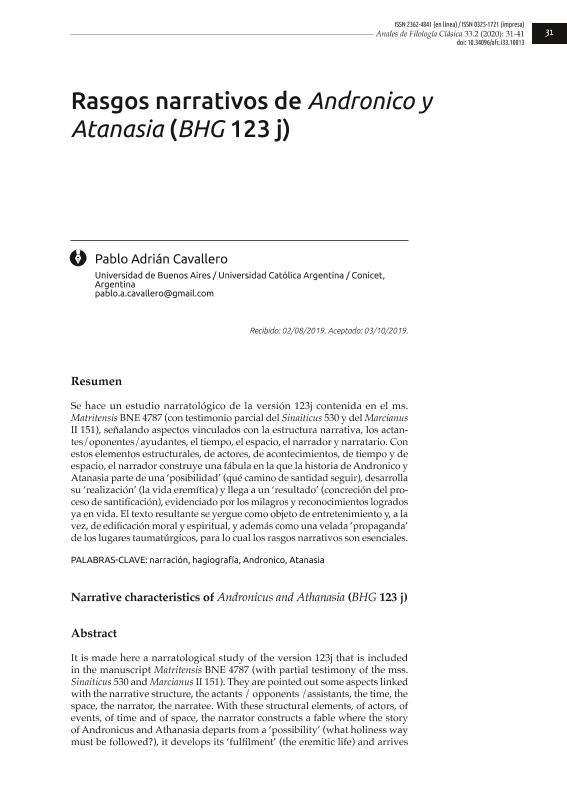Mostrar el registro sencillo del ítem
dc.contributor.author
Cavallero, Pablo Adrian

dc.date.available
2022-09-28T17:52:26Z
dc.date.issued
2020-12
dc.identifier.citation
Cavallero, Pablo Adrian; Rasgos narrativos de Andronico y Atanasia (BHG 123 j); Universidad de Buenos Aires. Facultad de Filosofía y Letras. Instituto de Filología Clásica; Anales de Filología Clásica; 2; 33; 12-2020; 31-41
dc.identifier.issn
0325-1721
dc.identifier.uri
http://hdl.handle.net/11336/170793
dc.description.abstract
Se hace un estudio narratológico de la versión 123j contenida en el ms. Matritensis BNE 4787 (con testimonio parcial del Sinaiticus 530 y del Marcianus II 151), señalando aspectos vinculados con la estructura narrativa, los actantes/oponentes/ayudantes, el tiempo, el espacio, el narrador y narratario. Con estos elementos estructurales, de actores, de acontecimientos, de tiempo y de espacio, el narrador construye una fábula en la que la historia de Andronico y Atanasia parte de una ‘posibilidad’ (qué camino de santidad seguir), desarrolla su ‘realización’ (la vida eremítica) y llega a un ‘resultado’ (concreción del proceso de santificación), evidenciado por los milagros y reconocimientos logrados ya en vida. El texto resultante se yergue como objeto de entretenimiento y, a la vez, de edificación moral y espiritual, y además como una velada ‘propaganda’ de los lugares taumatúrgicos, para lo cual los rasgos narrativos son esenciales.
dc.description.abstract
It is made here a narratological study of the version 123j that is included in the manuscript Matritensis BNE 4787 (with partial testimony of the mss. Sinaiticus 530 and Marcianus II 151). They are pointed out some aspects linked with the narrative structure, the actants / opponents /assistants, the time, the space, the narrator, the narratee. With these structural elements, of actors, of events, of time and of space, the narrator constructs a fable where the story of Andronicus and Athanasia departs from a ‘possibility’ (what holiness way must be followed?), it develops its ‘fulfilment’ (the eremitic life) and arrives to a ‘result’ (the concreteness of the holiness process), made evident by the miracles and awards achieved already in their lives. The resultant text appears as an entertainment subject and, at the same time, as a subject of moral and spiritual building, and as a hidden ‘propaganda’ of the thaumaturgic places; in order to achieve all that, the narrative characteristics are essential.
dc.format
application/pdf
dc.language.iso
spa
dc.publisher
Universidad de Buenos Aires. Facultad de Filosofía y Letras. Instituto de Filología Clásica
dc.rights
info:eu-repo/semantics/openAccess
dc.rights.uri
https://creativecommons.org/licenses/by-sa/2.5/ar/
dc.subject
BIZANCIO
dc.subject
HAGIOGRAFÍA
dc.subject
NARRATOLOGÍA
dc.subject
ANDRONICO Y ATANASIA
dc.subject.classification
Literaturas Específicas

dc.subject.classification
Lengua y Literatura

dc.subject.classification
HUMANIDADES

dc.title
Rasgos narrativos de Andronico y Atanasia (BHG 123 j)
dc.title
Narrative characteristics of Andronicus and Athanasia (BHG 123 j)
dc.type
info:eu-repo/semantics/article
dc.type
info:ar-repo/semantics/artículo
dc.type
info:eu-repo/semantics/publishedVersion
dc.date.updated
2022-09-23T15:42:29Z
dc.identifier.eissn
2362-4841
dc.journal.volume
2
dc.journal.number
33
dc.journal.pagination
31-41
dc.journal.pais
Argentina

dc.journal.ciudad
Buenos Aires
dc.description.fil
Fil: Cavallero, Pablo Adrian. Universidad de Buenos Aires. Facultad de Filosofía y Letras. Instituto de Filología Clásica; Argentina. Consejo Nacional de Investigaciones Científicas y Técnicas; Argentina
dc.journal.title
Anales de Filología Clásica
dc.relation.alternativeid
info:eu-repo/semantics/altIdentifier/url/http://revistascientificas.filo.uba.ar/index.php/afc/article/view/10013
Archivos asociados
